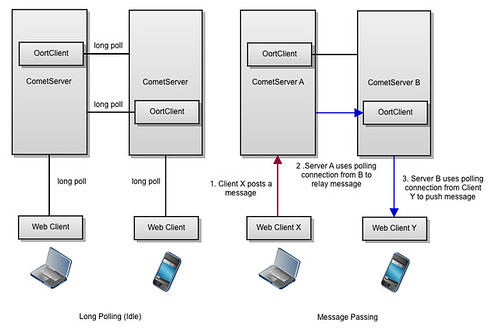Keeping everyone connected around photos
This post dives down into the inner working of Photo Session, which enables user to have a real time photo sharing experience on multiple platforms.
In order to synchronize the viewing experience on different browsers, we need to have a mechanism to pass the state of one browser to other browsers. There are emerging technologies that would allow messages to be passed to the browser by opening a connection (ex. WebSockets), but our goal was to enable this feature for multiple platforms. To support this requirement, we chose CometD as our server technology which enable browsers on multiple platform to handle push notification. CometD also allowed us to setup a server cluster to handle large number of requests.
Bayeux Protocol (a.k.a. Push Notification thingy)
The mechanism in which messages are passed around is as follows. As different browsers join a Photo Session, we connect them to one of our servers and leave that connection open. This is referred to as long polling. When Client X posts a message, it is first collected by the server it is connected to, Server A. Server B has a long polling connection open via Oort to listen for any message that comes through Server A. OortClient is simply a server-side client that enables message passing between servers. It employs the same mechanism to push message from server to client. Once Server B receives the message via Oort, it will then relay the message down to Client Y by using the same mechanism used by Oort.
This lightweight transport mechanism allows us to pass messages around with minimum latency. However, this comes with few limitations. One, it does not guarantee message ordering. Client Y would not know the message order which client X submitted the them. To hide this limitation, we simply pick the very last message that is received for any client. There would be cases where users will be temporarily be out of sync when multiple messages are passed around at once, but it will be correctly updated with subsequent messages. Another limitation is the lack of guarantee on message delivery. Since we do not check for ACK during message delivery, the client X does not know if the message has been received by client Y. Again, most of the message delivery limitation is masked by checking for the last message.

 This is a guest post by Teruhisa Haruguchi: Frontend Engineer in the Mobile & Presentation Service group. Main developer on the Flickr Photo Session project. Recent graduate from Cornell University with a concentration in Computer Graphics. Home country Japan.
This is a guest post by Teruhisa Haruguchi: Frontend Engineer in the Mobile & Presentation Service group. Main developer on the Flickr Photo Session project. Recent graduate from Cornell University with a concentration in Computer Graphics. Home country Japan.
